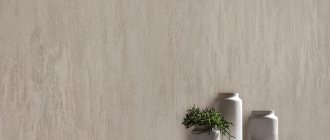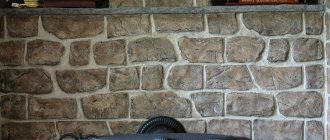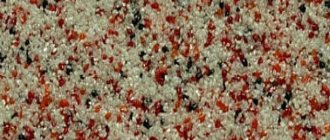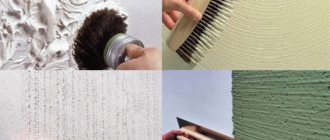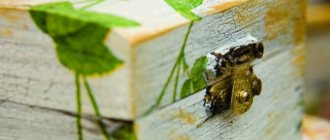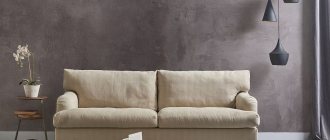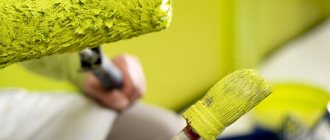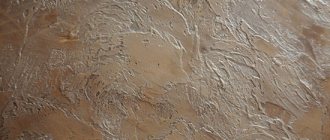Today we’ll talk about paint with a velvet effect. By and large, paint, regardless of its purpose and various effects, remains paint. If some time ago, manufacturers produced paint of certain colors, today most brands are focused on producing white paint with the desired effect, if required. All other shades are achieved by adding color.
Tinting paint now is not so much fashionable, but simply convenient. This way you achieve the required shade, thereby choosing your color to suit your taste and interior.
Of course, paint comes in different bases, such as water-based and emulsion. Washable paints are gaining great popularity today and this is understandable, because it is so easy to stain perfectly smooth and plain walls and, if necessary, you want to wash them in order to keep the interior in its original form.
Preparing the base
Before applying paint, it is necessary to prepare the walls well. Of course, paint does not hide the imperfections of the walls, so preparing for painting walls is always a more difficult process than preparing for other types of decor.
- First you need to check the walls for various types of peeling, cracks, defects, etc.
- After identifying problematic areas in your walls, we move on to eliminating defects.
- Next, you need to clean the surface from dust. Why do we use the primer mixture?
- Next, we move on to puttying the walls, thereby leveling the surface to an ideal state.
- Afterwards the wall must be cleaned with sandpaper.
- Before painting, the walls are primed again to create a good layer of adhesion.
Nuances of dyeing technology
Buying paints and varnishes is not the key to successful repairs. Although working with velvet paints and varnishes is not much different from conventional painting, you need to take into account some features of the emulsion.
Preparatory stage
Before applying the paint layer, the walls are first tidied up. Remove cracked plaster and smooth out defects with putty. Framing decor and stucco molding are shielded with masking tape. Dyes are added to the jar with the emulsion, the composition is thoroughly mixed. Prepare the necessary tools: a spatula, a tray for the water-based mixture, brushes of different sizes, a roller for velor coatings (it should absorb the paint, then transfer it to the surface), and a trowel.
Removing the old coating
Leveling the walls
Painting tool
Step-by-step instructions for the painting process
- The prepared walls are impregnated with a primer; it is better to choose acrylic mixtures that have good adhesion.
- Use a brush to apply velvet paint in hard-to-reach places: near doorways, windows, along the border with the ceiling, floor.
- Large spaces are painted with a special velor roller.
- The first, background layer of coating is smoothed and leveled with smoothers. The emulsion is allowed to dry. The layer is made thick; this is the base of the coating.
- The second (finishing) is left natural. The surface should not be perfectly smooth; grains of sand remain on the surface, creating a unique texture. The paint is applied in a thin layer with chaotic movements. With a second layer you can adjust the color; when dry, the emulsion becomes lighter.
Pay attention to: Water-based paint - purpose, advantages, application
Using relief rollers, they achieve unusual decoration and textured surfaces. Compositions with mother-of-pearl look especially impressive. They radically change the space and visually expand the walls.
Prime the walls
Paint hard-to-reach places with a brush
Applying paint to the wall
How to paint walls with velvet effect paint
Now let's move on to painting the walls. To achieve a velvet effect, it is necessary to paint using a special method.
- First of all, take a narrow brush and paint a thin layer of all difficult places, such as corners and other areas of the walls that cannot be reached with a roller.
- Next, pour the paint into the container and evenly distribute it over the roller, form the first thin, uniform layer and leave it to dry overnight.
- Afterwards, you need to take a trowel and use it, as in the case of working with plaster, to apply a second layer of paint in a chaotic sequence, forming movements in different directions. After drying a little, it is advisable to adjust the paint and slightly smooth out the transitions. Leave it until completely dry.
- Next, we repeat exactly the same way, applying a third layer of paint and again adjusting it after drying a little. Achieving a velvet effect.
Of course, it is difficult to explain in words how to properly perform this kind of creative work. If you understand what velvet looks like, then you probably understand what you should ultimately achieve.
Without practice, it is quite difficult to recreate the correct velvet effect the first time, so we recommend that you use a small section of the wall and practice shortly before applying paint in the main room.
Manufacturers and price review
When purchasing textured paint (decorative plaster), you should take a responsible approach to choosing the manufacturer and strive for a low price. Cheap mixtures can be disappointing: they do not adhere well to the surface, crack or fade after application.
The top best manufacturers of textured paint, according to user reviews, include the following companies and brands:
- VGT (Russia) presents a wide selection of textured paints with different reliefs, price from 900 rubles. for 9 kg;
- Baumit (Austria) produces high-quality wear-resistant compounds for finishing internal and external walls, price from 500 rubles. for 25 kg (mineral) and from 5000 for 25 kg (silicone);
- Ticiana (Italy) creates high-quality coating with different textures for interior decoration, price from 700 rub. for 1.5 kg;
- De Luxe bark beetle, mineral, for interior decoration, price about 350 rub. for 25 kg;
- Perel (silicone, acrylic), price from 1300 rub. for 18 kg;
- Lakra (Russia) acrylic white paint with the addition of marble chips, used for interior work, price from 900 rub. for 9 kg;
- Clavel (France) offers various types of decorative plasters, manufactured in compliance with environmental standards, price from 1400 rubles. for 5 kg.
Conclusions on the topic
So, today we introduced you to velvet effect paint. Of course, despite the fact that we are dealing with paint, the approach to achieving the desired effect is more reminiscent of applying plaster, because we use a special trowel for this.
We should also not forget that color is of great importance to achieve the velvet effect. It is advisable to have a piece of velvet of the desired color and simply ask for the paint to be chipped to bring its shade as close as possible to natural velvet. In such work, you need to pay attention to all the little things.
If you still have unanswered questions, ask us in the comments, and our authors or readers will be happy to answer you.
Happy renovation!
LMB selection
In the photo - decorative plaster used to decorate the living room
To obtain the desired decorative effect, you need special velvet wall paint. These paints and varnishes are produced by a number of foreign and domestic brands.
Important: Given the relatively similar quality of the result obtained, the price of domestic paints and varnishes is an order of magnitude more affordable than the cost of imported analogues.
Velvet effect wall paints available in the market are a wide range of water-based materials. Paintwork materials are produced in a basic white version, which can be tinted by adding pigments in accordance with personal preferences or interior features.
In the photo - a label of domestic paint with a velvet effect
Coverings with the effect of fleecy fabrics do not have a pronounced odor, dry quickly, and are resistant to ultraviolet rays. The complete set of paints and varnishes with a corduroy or velvet effect includes a background substrate and the paint itself.
Among domestic brands of coatings with this effect, Velvet – Asti is especially popular.
Important: Purchasing special paints and varnishes in itself is not a guarantee of success, since compliance with the application technology is no less important.
Painting features
Velvet effect paint is essentially a type of decorative plaster that is applied to walls or other coatings in stages. Considering that the quality of the result obtained depends on the correct execution of each stage, it is important to comply with the technology given below and the paint manufacturer’s instructions.
Application of paints and varnishes is allowed only on a previously prepared surface.
For painting work we will use simple accessible tools, including:
- maklavica brush,
- narrow hand brush for treating hard-to-reach areas,
- velor roller,
- medium thickness spatula,
- plaster trowel.
Preparing the base
The instructions for preparing the base include the following points:
- We check the walls for damage to reliefs and peeling areas of plaster.
- If any surface imperfections are identified, we eliminate them. For example, we knock down the flaking fragments of plaster, and grind the protruding reliefs.
- Then the surface is dusted and primed.
- After the soil has completely dried, the wall is leveled with putty. You can learn how to putty certain surfaces by reading the relevant articles posted on our portal.
- Next, we use masking tape to glue the baguettes and other decorative elements that are not planned to be painted.
- For better adhesion, we cover the leveled base with a layer of deep penetration acrylic primer.
Important: Regardless of how the primer is applied, it is important to ensure that no smudges form on the surface, as this will subsequently negatively affect the quality of the paint.
Let's start painting
Applying background paint
- Open a can of paint. If you haven’t added color before, do it now and thoroughly mix the resulting solution until a homogeneous consistency is formed. At the same stage, you can dilute the paintwork with water at the rate of 10-15% of the total volume and mix thoroughly again.
- Using a narrow brush, draw a starting line 5-10 cm wide under the baguettes. This is done so that later it will be more convenient to work with a roller and not stain the ceiling.
- The first layer - the background is applied with a velor roller. The work is not difficult, but requires accuracy and patience.
- Pour the paint into a paint tray and, dipping a roller into it, roll vertical stripes. At this stage it is important to achieve good uniform painting, otherwise you will have to apply another layer later.
- After the background is applied, leave it to dry overnight.
Applying a decorative layer
Applying the first decorative layer
Open the jar with the appropriate composition and again mix thoroughly. There is no need to pour the composition into the tray, since we will work from a standard container. Using a spatula, apply the composition to the trowel and spread it with arbitrary movements over the surface of the wall.
The first decorative layer should be thin. It is important to ensure that it is smooth. That is, if there is protrusion of the material during application, smooth it out immediately. If there are small depressions, no problem - leave them, since when applying the second layer the relief will be more obvious.
As the first decorative layer dries, it acquires a clearly noticeable silkiness. We can enhance this effect with the next layer.
The photo shows the final layer of decorative painting
The second finishing layer is slightly thicker than the first and is applied with the same trowel. The movements of the trowel during application are circular and chaotic. The radius of circular movements does not exceed 20 cm. Due to the small radius, you can achieve the effect of velvety tints.
We do not immediately level the applied layer. After the applied paint begins to dry out a little in a certain area, we take a trowel and begin to level it with a little pressure.
It will no longer be possible to eliminate the relief, but it will be possible to smooth out the unevenness on top. That is, we are polishing the finishing decorative layer. As a result, the effect of heterogeneous velvety will be obtained.
Silk walls
The Chinese Empire gave the world amazing fabric. Light, delicate, amazingly beautiful material quickly gained popularity in many countries. Of course, we are talking about silk - one of the most ancient and expensive fabrics.
The nobility and nobility in Russia, Europe and the East decorated the rooms of their palaces and mansions with silk fabric.
As already mentioned, such a whim was intended not only to give the interior an aesthetic appearance, but also to show the status of the owner. Indeed, due to the high cost of fabric, such pleasure was available to a rather narrow circle of people, including members of royal families.
Now everyone can afford such pleasure. This became possible thanks to special paint.
Painting materials for walls with the effect of silk fabric make you feel like you are in an imperial palace, even if you live in an ordinary city apartment. The effect of silk-covered walls is so complete that you constantly want to touch the surface.
Natural shine, as well as imitation of real silk fabric, is achieved using special paint components. But it is no less important in this matter to correctly apply painting and priming materials to the surface to be painted.
Velvet paint: nuances in work
Some manufacturers recommend applying a top coat of varnish after the paint has dried. This coating is applied with a thin film that protects the original surfaces from mechanical damage and moisture.
To get a deeper color you need to apply the coloring composition twice. This will significantly increase paint consumption, but the result will be much better. The walls are pre-treated with a trowel to create a smooth base.
And, although natural fabric is a fragile and easily torn material, the paint and varnish coating increases the service life and unpretentiousness. It is difficult to get dirty, so even in typical places where wallpaper gets dirty, around switches and corners, it can be easily washed with ordinary soapy water or water.
Most paints are resistant to damaging factors. However, before purchasing, you should study the care label.
This coating is easy to apply. It will make the house more elite and luxurious.
